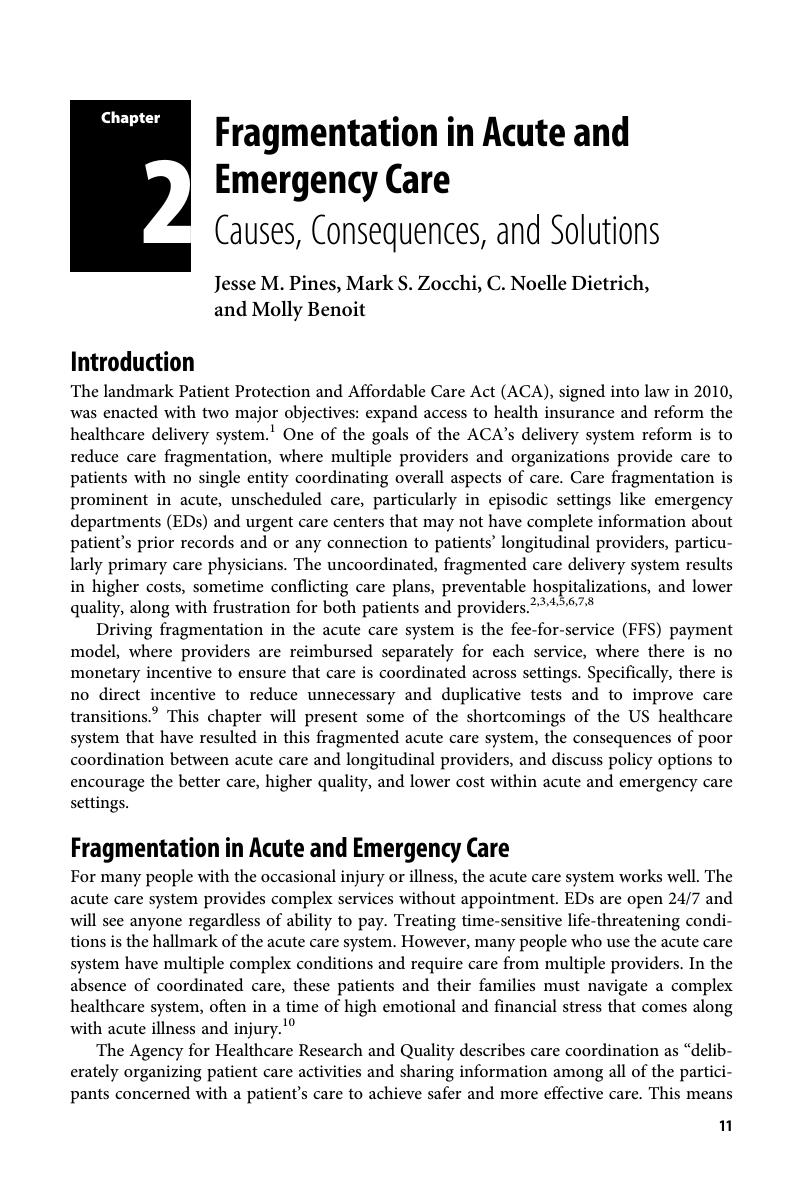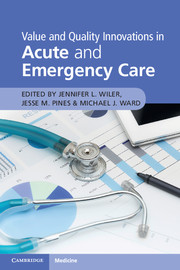Book contents
- Value and Quality Innovations in Acute and Emergency Care
- Value and Quality Innovations in Acute and Emergency Care
- Copyright page
- Dedication
- Contents
- Contributors
- Foreword: Delivery System Reform – License to Innovate
- Preface
- Chapter 1 Fifty Years of Transformation of Acute and Emergency Care
- Chapter 2 Fragmentation in Acute and Emergency Care
- Chapter 3 Measuring and Improving Quality of Care
- Chapter 4 Alternative Payment Models in Acute, Episodic Care
- Chapter 5 Improving Timeliness and Access of Acute and Emergency Care
- Chapter 6 Bringing the Patient Voice into Emergency Care
- Case 1 Expanding the Role of Observation Care
- Case 2 An Innovative Strategy to Streamline Care for Behavioral Health in the Emergency Department
- Case 3 The Geriatric Emergency Department
- Case 4 How the United Kingdom Responded to the 4-Hour Rule
- Case 5 High-Cost Users
- Case 6 Emergency Care in an Integrated Healthcare Delivery System
- Case 7 Urgent Care Centers
- Case 8 The “No-Wait” Emergency Department
- Case 9 Transforming Care Delivery through Telemedicine
- Case 10 Coordinating Emergency Care through Telemedicine
- Case 11 Bringing Diagnostic Testing to the Bedside
- Case 12 Regionalization of Care
- Case 13 Clinical Decision Support Tools
- Case 14 Automated Patient Follow-Up Program
- Case 15 Using Data on Patient Experience to Improve Clinical Care
- Case 16 Community Paramedicine
- Case 17 Initiating Palliative Care in the Emergency Department
- Case 18 Streamlining Patient Flow in the Emergency Department with Discrete Event Simulation
- Case 19 Using Emergency Department Community Health Workers as a Bridge to Ongoing Care for Frequent ED Users
- Case 20 Big Data
- Index
- References
Chapter 2 - Fragmentation in Acute and Emergency Care
Causes, Consequences, and Solutions
Published online by Cambridge University Press: 04 July 2017
- Value and Quality Innovations in Acute and Emergency Care
- Value and Quality Innovations in Acute and Emergency Care
- Copyright page
- Dedication
- Contents
- Contributors
- Foreword: Delivery System Reform – License to Innovate
- Preface
- Chapter 1 Fifty Years of Transformation of Acute and Emergency Care
- Chapter 2 Fragmentation in Acute and Emergency Care
- Chapter 3 Measuring and Improving Quality of Care
- Chapter 4 Alternative Payment Models in Acute, Episodic Care
- Chapter 5 Improving Timeliness and Access of Acute and Emergency Care
- Chapter 6 Bringing the Patient Voice into Emergency Care
- Case 1 Expanding the Role of Observation Care
- Case 2 An Innovative Strategy to Streamline Care for Behavioral Health in the Emergency Department
- Case 3 The Geriatric Emergency Department
- Case 4 How the United Kingdom Responded to the 4-Hour Rule
- Case 5 High-Cost Users
- Case 6 Emergency Care in an Integrated Healthcare Delivery System
- Case 7 Urgent Care Centers
- Case 8 The “No-Wait” Emergency Department
- Case 9 Transforming Care Delivery through Telemedicine
- Case 10 Coordinating Emergency Care through Telemedicine
- Case 11 Bringing Diagnostic Testing to the Bedside
- Case 12 Regionalization of Care
- Case 13 Clinical Decision Support Tools
- Case 14 Automated Patient Follow-Up Program
- Case 15 Using Data on Patient Experience to Improve Clinical Care
- Case 16 Community Paramedicine
- Case 17 Initiating Palliative Care in the Emergency Department
- Case 18 Streamlining Patient Flow in the Emergency Department with Discrete Event Simulation
- Case 19 Using Emergency Department Community Health Workers as a Bridge to Ongoing Care for Frequent ED Users
- Case 20 Big Data
- Index
- References
Summary

- Type
- Chapter
- Information
- Publisher: Cambridge University PressPrint publication year: 2017

